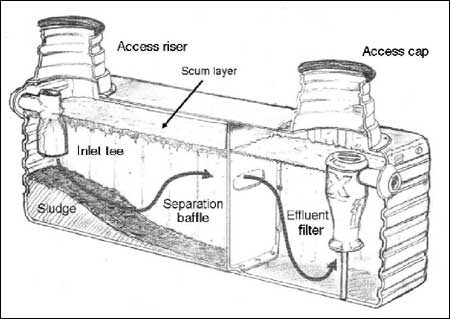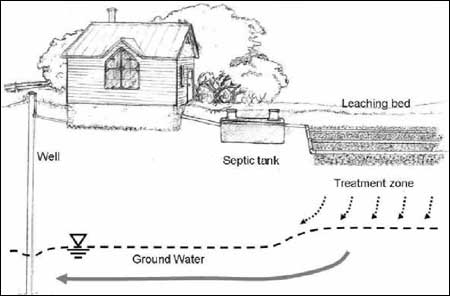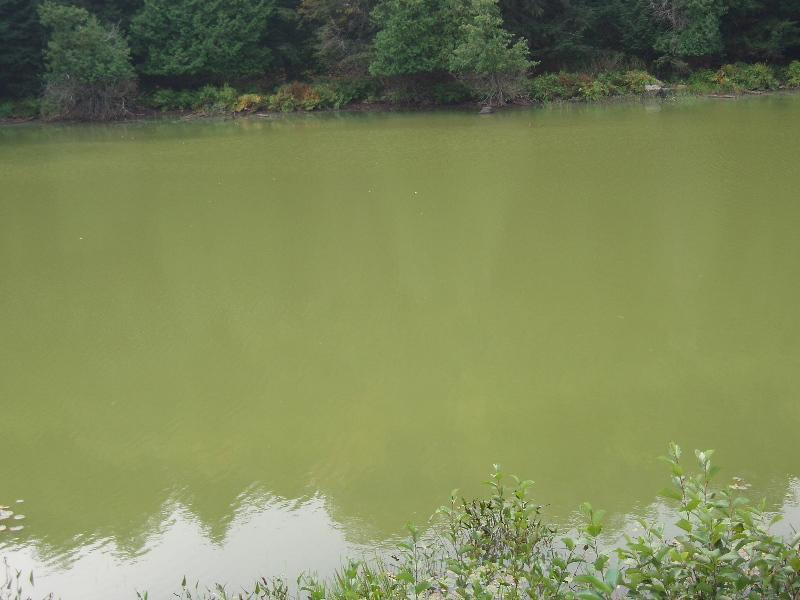We know you’ve heard it before but…
Oxtongue is a lake that has had many cottages for decades, and even centuries, and so we are at a risk of unintentionally polluting our nice clean water. Household waste, from all house drains, empty first into the septic tank. Once in the septic tank it is broken down by bacteria, converting waste into mostly water, carbon dioxide, mineral ash and more bacteria. Ideally after this bacterial process, clean, clear effluent (waste water) then flows out of the tank and into the tile bed (leaching bed) where the effluent percolates into the soil. The cleaner this effluent is, the less pollution goes into the soil. Unclean effluent that carries disease causing organisms and pathogens, can further move into our shallow ground water, infiltrate into our deeper aquifers and then subsequently discharge into our lake and our wells. Algal Blooms have occurred in Algonquin Park, and while the source of algal bloom is still being researched, we do know that the Nitrogen and Phosphorus released from septics systems can negatively impact water quality, cause algal blooms and pollute our drinking and swimming water. We pride ourselves on our clean water…let’s keep it that way.
If you prefer the visual there is a fantastic video at the bottom of this page…

Ontario Onsite Wastewater Association

Virginia Suffolk
Natural Bacterias help!
Foca recommends not using special additives that are touted to enhance the performance of your tank or system, instead use natural ones:
Flush a cup of yoghurt or liver every month down your toilet to help aid in bacterial production in your septic tank.
How often and Best time of year to pump?
You should be pumping and inspecting your system every 3-5 years. When you do, the best time of year to pump is the summer and early fall. You want to allow sufficient time before the winter for the tank to refill and bacterial activity to become re-established. The spring can have too high a water table, and the ground around the tank may still be frozen.
Know your System!
Get to know your system, read __ and even keep an “as built” system diagram in a safe place for reference. It’s also helpful to install risers to to allow for easy access to the manholes.
Common problems you may not even know are happening…
BUT solutions you can solve!
The more efficiently your Septic System operates, the less pollution goes into the environment.
Overloading Sewage
Every time water goes down the drain into your septic, the same amount of liquid leaves the tank to the leaching bed. With too many guests or flushes, waste can be forced from the tank too soon – amd untreated waste, including solids can clog up pipes or enter the leaching bed
Solution
- conserve water (only one load of laundry a day, short showers, spread out water usage)
- don’t connect rain gutters to connect or flow into a sewage system,
- post signs for guests (see some here)
- make sure that the size of your system can handle your quantity. We may have more families sharing one cottage and guests than in the past and the initial or old septic may never have been designed for that load.
Build up of Solids
Fats, grease and oils don’t break down in septics and can form a scum layer at the top of the septic tank. Also coffee grounds, egg shells, facial tissue, hair, tampons, and other common sewage items can inhibit the work of the bacteria. Too much of these products and tanks can fill quickly and combined they can clog the system and reduce it’s effectiveness.
Solution
- these products go in the garbage, not the drain.
- avoid garburators.
- Effluent filters (which must be cleaned regularly) are recommended to help reduce the amount of solids entering the pipes and leaching bed
Bacteria and Enzymes are a good thing! Don’t kill it!
Bacteria and enzymes in your septic tank break down the sewage before it flows to the leaching bed. Those bacteria are harmed or killed by cleaning products containing antibacterial, non-biodegradable, or chlorine-based products. Varnish, paint, pesticides and gas should never be put into a septic system. Only ONE load of dishes using a regular detergent can kill ALL the good bacteria in your system for up to 70 hours.
Solution
- Use septic friendly products (drain cleaners, regular cleaning products)
- Use low phosphate or phosphate free cleaners
- Don’t use anti-bacterial cleaners or laundry/dishwasher detergents with bleach
- Don’t use dishwasher rinse aids (use lemon juice instead)
- Don’t do cold water washing.
- Don’t use automatic toilet bowl cleaners
- Use caution, when installing water softeners
Leaking Sewage
If your tank is damaged and leaking the waste (and contaminated water) is going straight to the ground and water system.
Solution
- regular maintenance is the most important step. It is much less expensive to have it maintained and keeps emergencies at bay. Have your tank inspected and pumped every 3-5 years
Poisoned ground and water
Hazardous products that go down the drain, come out just like they went in but now they are in the ground and water system.
Solution
- these products go in the garbage, not the drain.
Cracked Pipes
Cracked pipes will allow waste water to escape and reduce the effectiveness of your leaching bed or overall system. Roots (even from long rooted garden plants) will seek out and crack your pipes or inhibit the leaching bed.
Solution
- Don’t drive or dig around your tank or leaching bed
- Don’t plant trees around your tank or leaching bed
- Ensure your leaching bed has only shallow rooted ground cover over it.
You know it's gone too far when...
You have:
slow drains
sewage back up
odour in the vicinity of the bed
wet & soggy areas in the bed area
striping of lawn and patchy growth
leaking in the area bed
Read more about your septic system from these great sources:
FOCA
- Help! I need a new Septic System (PDF – excerpt from the FOCA Newsletter, Fall 2011)
- Septic System Factsheet (pdf; 2 pages) (FOCA)
- Poop Talk – It’s All About The Water (Vimeo link; Coalition of Haliburton Property Owners’ Associations) – Getting to know your septic system, with Rob Davis.
- On‐Site Sewage System Maintenance Inspections (pdf; 7 pages) (MMAH)
- Septics and Maintenance Inspections Overview (pdf; 31 pages) (Peterborough Health Unit)
- Septic Systems 101 (pdf; 37 pages) ( Ontario Onsite Wastewater Association)
- Find a Septic Expert (Ontario Onsite Wastewater Association)
- Septic Smart Videos (OMAFRA)
Coalition of Halibuton Property Owners Associations

